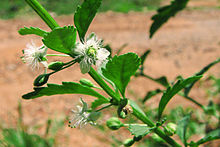Scoparia dulcis
Appearance
| Scoparia dulcis | |
|---|---|

| |
| Scientific classification | |
| Kingdom: | Plantae |
| Clade: | Tracheophytes |
| Clade: | Angiosperms |
| Clade: | Eudicots |
| Clade: | Asterids |
| Order: | Lamiales |
| Family: | Plantaginaceae |
| Genus: | Scoparia |
| Species: | S. dulcis
|
| Binomial name | |
| Scoparia dulcis | |
| Synonyms[1] | |
| |

Scoparia dulcis is a species of flowering plant in the plantain family. Common names include licorice weed,[2] goatweed,[3] scoparia-weed and sweet-broom in English, tapeiçava, tapixaba, and vassourinha in Portuguese, escobillo in Spanish, and tipychä kuratu in Guarani.[4] It is native to the Neotropics but it can be found throughout the tropical and subtropical world.[4]
Although S. dulcis is considered a
American citrus groves.[3]
Traditional medicine
As a traditional medicine, S. dulcis has been used for diabetes in India and hypertension in Taiwan.[6] In Siddha medicine it is used for treatment of kidney stones, but it needs rigorous diet method. It is called kallurukki (stone melter) in
Malayalam and Tamil. In Brazil, it has been used for various problems such as hemorrhoids and wounds.[7]
Chemical constituents
Chemicals that have been isolated from S. dulcis include
Gallery
-
Flower of Scoparia dulcis
-
Scoparia dulcis, near F.Cl. de Patako, Senegal
-
Flower of Scoparia dulcis
-
Scoparia dulcis
-
New leaves of Scoparia dulcis
-
Scoparia dulcis plant
References
- ^ The Plant List: A Working List of All Plant Species, retrieved 22 May 2016
- ^ USDA, NRCS (n.d.). "Scoparia dulcis". The PLANTS Database (plants.usda.gov). Greensboro, North Carolina: National Plant Data Team. Retrieved 8 November 2015.
- ^ JSTOR 4044996.
- ^ a b "Scoparia dulcis". Germplasm Resources Information Network. Agricultural Research Service, United States Department of Agriculture. Retrieved 19 January 2018.
- ^ Majumder, S; Rahman, MM; Bhadra, SK (2011). "Micropropagation of Scoparia dulcis Linn. through induction of indirect organogenesis" (PDF). Asia-Pacific Journal of Molecular Biology and Biotechnology. 19 (1): 11–7.
- PMID 15522116.
- S2CID 32597981.
- PMID 11534346.
- ^ Phan, Minh Giang (2006). "Chemical and Biological Evaluation on Scopadulane-Type Diterpenoids from Scoparia dulcis of Vietnamese Origin". Chemical and Pharmaceutical Bulletin. 54 (4): 546–549.
- ^ Chiu-Ming Chen; Ming-Tyan Chen (1976). “6-Methoxybenzoxazolinone and Triterpenoids from Roots of Scoparia dulcis” Phytochemistry, 15:1997-1999.
External links
 Media related to Scoparia dulcis at Wikimedia Commons
Media related to Scoparia dulcis at Wikimedia Commons- Scoparia dulcis in West African plants – A Photo Guide.






